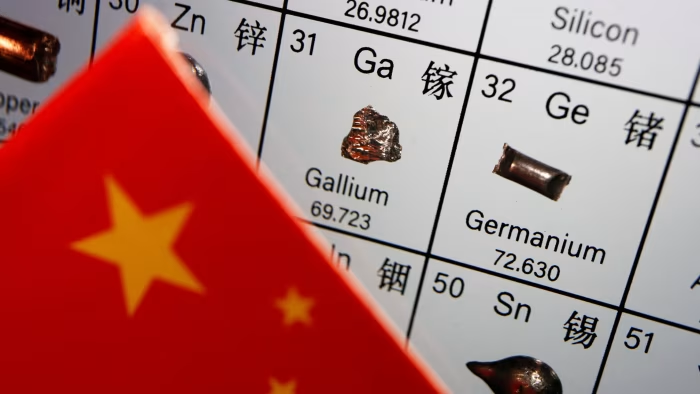Pakistan’s Air Force stunned India on April 29-30, 2025, by jamming four Rafale jets near the Kashmir Line of Control, forcing them to retreat in chaos. This clash highlights electronic warfare, a silent weapon that cripples enemy systems without bullets. Electronic warfare disrupts radars and communications, shifting battle outcomes. The article aims to explain electronic warfare technology through Pakistan’s victory, examines China’s role in its capabilities, exposes the U.S. Air Force’s reliance on fragile systems, and reveals a crippling dependence on Chinese-controlled minerals. Boyko Nikolov, a defense journalist at BulgarianMilitary.com, reported, “Pakistan’s Defense Minister Khawaja Asif claims that four Indian Rafale jets were electronically jammed and forced to retreat during border tensions on April 29–30.”

Understanding Electronic Warfare
Electronic warfare manipulates electromagnetic signals to confuse or disable enemy equipment. It overwhelms radars with noise, generates false targets, or detects enemy signals for strikes. In the Pakistan-India clash, Pakistan’s jamming paralyzed Rafale jets’ radar and communications, triggering emergency landings in Srinagar. Key terms simplify the concept. AESA, or Active Electronically Scanned Array, refers to advanced radars that resist jamming. DRFM, Digital Radio Frequency Memory, captures and alters radar signals to trick enemies. An EW suite integrates jamming and detection tools. For example, Pakistan’s success demonstrates how electronic warfare secures victories without physical combat. Clash Report on X stated, “Pakistan’s Defense Minister Khawaja Asif claims that four Indian Rafale jets were electronically jammed and forced to retreat during border tensions on April 29–30.”
Pakistan and China’s Warfare Dominance
Pakistan’s Air Force leverages Chinese technology to excel in electronic warfare. The Chengdu J-10C fighter, pivotal in the April 2025 incident, employs advanced EW systems, likely KG300G or KG600 jammers. These systems used DRFM to overpower the Rafale’s SPECTRA defenses, disrupting its sensors. Ground-based EW units boosted Pakistan’s airborne jammers with high-energy signals. Pakistan also integrates Chinese FD-2000 and HQ-9BE air defense systems, which embed EW to neutralize threats. Boyko Nikolov, a defense journalist at BulgarianMilitary.com, noted, “What sets the J-10C apart in this context is its reported integration of advanced electronic warfare systems.”
China fuels Pakistan’s capabilities with superior technology. The People’s Liberation Army Air Force deploys J-20 and J-35 stealth fighters with powerful EW suites. China’s Strategic Support Force merges EW and cyber operations for coordinated attacks. Pakistan gains from China’s exports, including PL-15 missiles and JY-27A radars at Mianwali Air Base. The Centre for Strategic and Contemporary Research observed, “The Chinese recognise the complementarities between the electronic and cyber warfares.” Therefore, Pakistan’s jamming of Indian jets showcases China’s rising dominance in electronic warfare technology.
U.S. Air Force’s Warfare Systems
The U.S. Air Force deploys sophisticated electronic warfare systems to confront global challenges. The F-22 Raptor uses the ALR-94 system for passive detection and stealthy jamming, evading enemy radar. The F-35 Lightning II’s AN/ASQ-239 Barracuda system combines radar, infrared, and jamming for enhanced awareness. A 2023 India.com report stated, “F-35 has excellent electronic warfare capabilities—the ability to jam enemy sensors.” The EA-18G Growler, a specialized EW aircraft, wields the ALQ-249 Next Generation Jammer to block enemy communications across wide areas.
Supporting systems bolster U.S. capabilities. The 350th Spectrum Warfare Wing, reactivated in 2025, updates mission data files swiftly. The E-7 Wedgetail synchronizes EW in real time with networked platforms. In 2024, a $97.3 million contract equipped F-35s with AGM-88G HARM missiles, targeting enemy radars. Exercises like Red Flag 24-2 test these systems in simulated battles. Lt. Col. Luke Marron, 23d Electronic Warfare Squadron commander, declared, “The 23d Electronic Warfare Squadron will be the shield that protects our forces, the sword that disrupts our enemies.” Nevertheless, these systems face a severe vulnerability.
Rare Earth Minerals: U.S. Dependency
Rare earth minerals, such as gallium, fuel electronic warfare systems. Gallium powers AESA radars and EW amplifiers in F-22 and F-35 jets, enabling precise jamming and detection. China dominates over 70% of global gallium production, supplying U.S. defense contractors. This dependence creates a strategic weakness. In 2024, China banned gallium exports, severing U.S. access to a vital resource. Defense News reported, “China’s export restrictions on gallium and germanium are a direct hit to the U.S. defense industry.”
Establishing domestic gallium production presents formidable obstacles. Extraction demands refining bauxite in energy-heavy processes. Constructing a U.S. gallium facility could cost $500 million to $1 billion. Operation would require three to five years, yielding only raw material, not finished components. For example, the ban stalls F-35 production and upgrades, undermining U.S. electronic warfare readiness. The paradox is clear: America’s advanced jets rely on Chinese minerals, leaving them at Beijing’s mercy.

U.S. Challenges Against Chinese Threats
Chinese electronic warfare, as demonstrated in Pakistan’s jamming of Rafale jets, endangers U.S. fighters. High-powered jammers could impair F-22 and F-35 radar and communications in intense combat zones. Ground-based EW systems, like those Pakistan deployed, heighten this threat by overloading sensors. China’s AI-driven “kill web” tactics, tested in 2024 naval exercises, adjust jamming patterns instantly, outmaneuvering U.S. responses. Boyko Nikolov, a defense journalist at BulgarianMilitary.com, noted, “Electronic warfare has become a critical domain in military strategy, with nations like the United States, Russia, and China investing heavily.”
U.S. shortcomings intensify the challenge. Training falls short, with 2019 reports revealing unpreparedness for realistic EW scenarios. China, conversely, conducts regular EW drills, granting allies like Pakistan an advantage. The gallium ban further hampers F-35 production, reducing available jets. Reports of China stealing F-35 design data suggest Beijing crafts EW strategies to exploit U.S. systems. The F-22’s limited fleet and the F-35’s dependence on fragile communication links compound the issue. Hence, the U.S. confronts significant obstacles with no immediate solutions.
Exposing U.S. Vulnerabilities in Warfare
Pakistan’s jamming of Indian jets in April 2025 exposes the potency of electronic warfare. China’s technology, wielded by Pakistan, disrupted advanced systems effortlessly. The U.S. Air Force possesses sophisticated EW tools, yet its dependence on Chinese gallium and inadequate training reveal profound weaknesses. Boyko Nikolov, a defense journalist at BulgarianMilitary.com, warned, “China’s advancements suggest it is catching up, leveraging its industrial base to produce cost-effective systems.” The U.S. struggles to counter Chinese-style EW threats, hampered by supply chain issues and stolen data. This clash underscores America’s exposed position, as China’s influence in electronic warfare grows unchecked.

